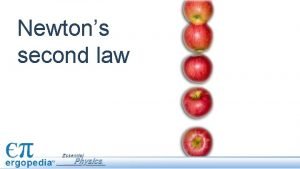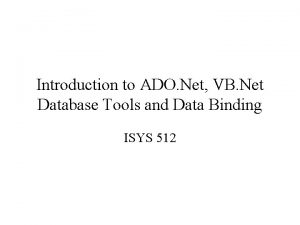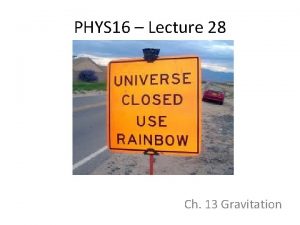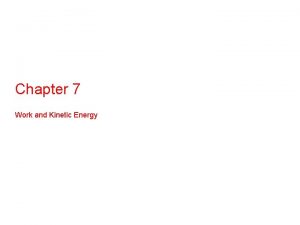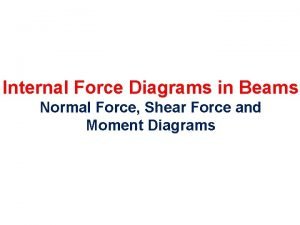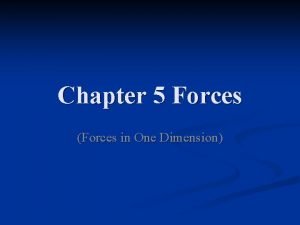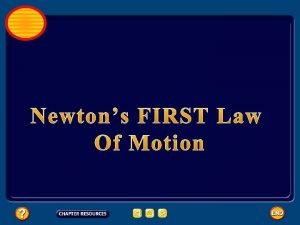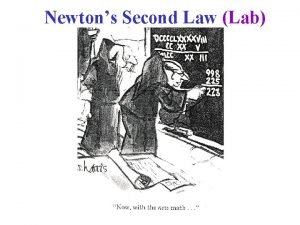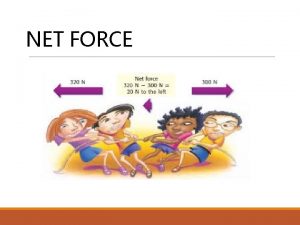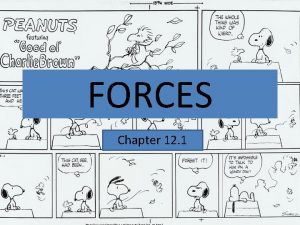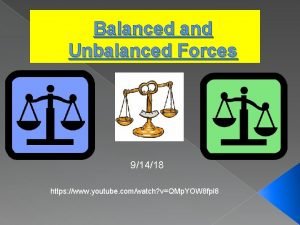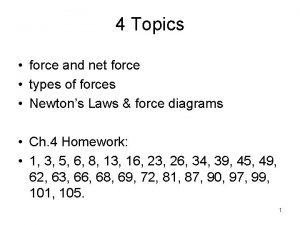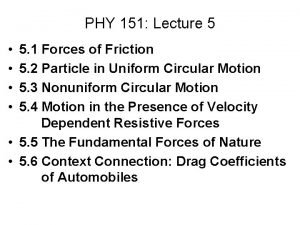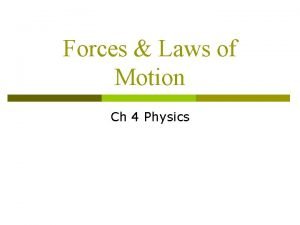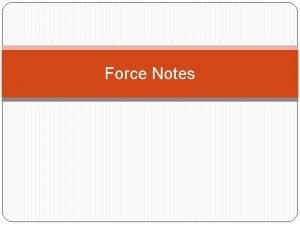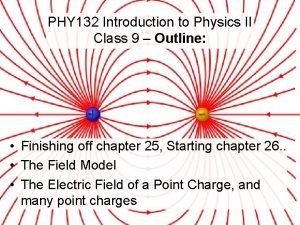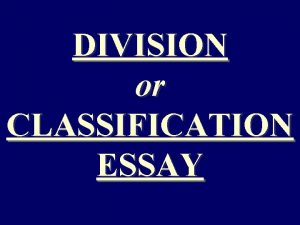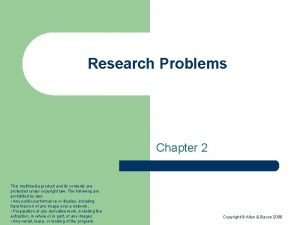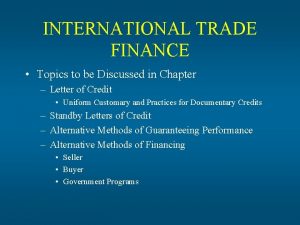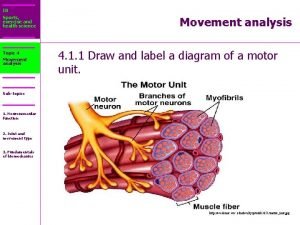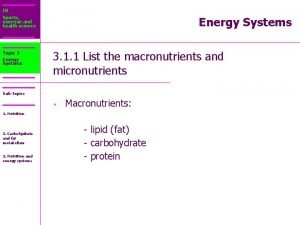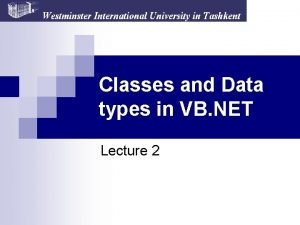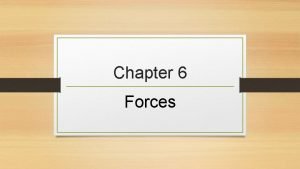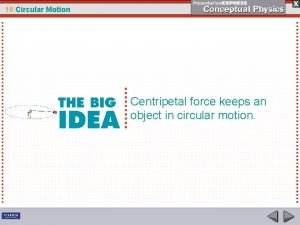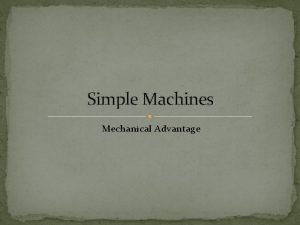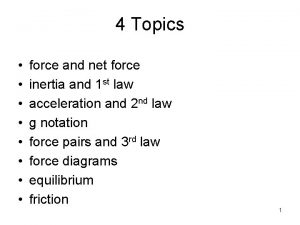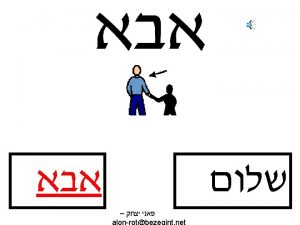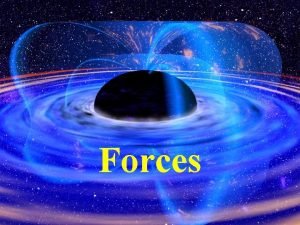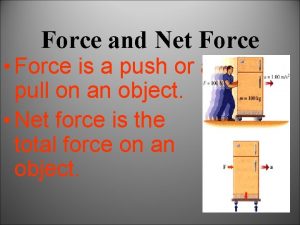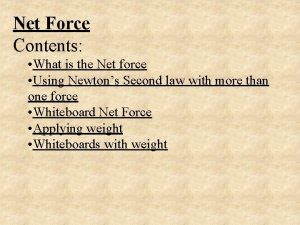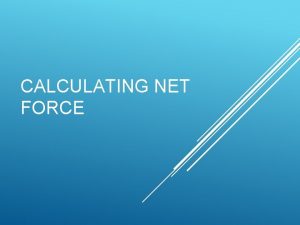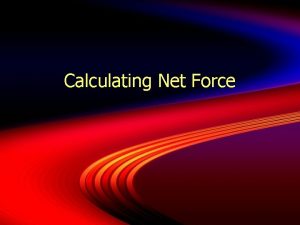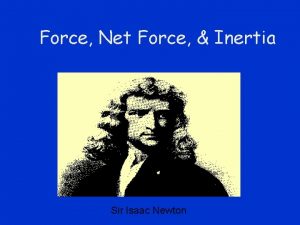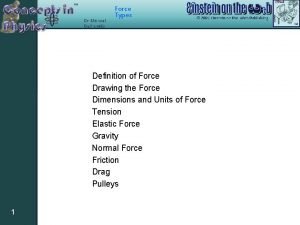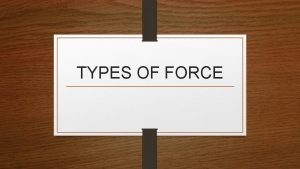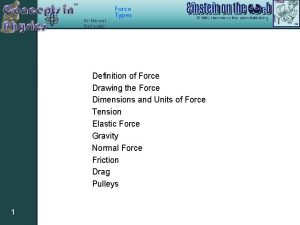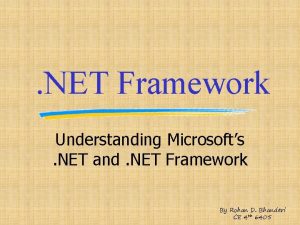4 Topics force and net force types of












































- Slides: 44

4 Topics • force and net force • types of forces • Newton’s Laws & force diagrams • Ch. 4 Homework: • 1, 3, 5, 6, 8, 13, 16, 23, 26, 34, 39, 45, 49, 62, 63, 66, 68, 69, 72, 81, 87, 90, 97, 99, 101, 105. 1

Force Concept Force = push or pull Contact Forces – requires touch Ex: car on road, ball bounce Non-Contact – does not require touch Ex: magnetism, gravity 2

Force Label Notation • Each force gets a distinctive label, and sketch & context supplies the interaction information • F – general force • FN – normal force • f – frictional force • W – weight • T – tension force 3

Net Force vector sum of all forces acting on an object 4

Example: Net Force = 0, Ball rolls along a smooth level surface constant velocity Force Diagram table force Fnet = 0 a=0 weight force 5

Newton’s First Law: An object maintains an unchanged constant velocity unless or until it is acted on by a nonzero Net Force. Example Motion Diagram when Fnet = 0 6

Force Diagrams • Object is drawn as a “point” • Each force is drawn as a “pulling” vector • Each force is labeled • Relevant Angles are shown • x, y axes are written offset from diagram • Only forces which act ON the object are shown 7

Example of a Force Diagram for a Sled net force equals the mass times its acceleration. 8

Newton’s Second Law: acceleration equals Net External Force (on object) divided by object mass: Example Motion Diagrams when Fnet ≠ 0 9

g’s • one “g” of acceleration = 9. 8 m/s/s • “two g’s” = 19. 6 m/s/s, etc. • Example: What is the net force on a 2100 kg SUV that is accelerating at 0. 75 g? 10

units • • Force units (SI): newton, N 4. 45 N = 1 lb. 1 N = (1 kg)(1 m/s/s) N/kg = m/s/s 11

Inertia • is ‘resistance’ to change in velocity • Ex: accelerating a ping pong ball • Ex: accelerating a train • Measurement: Mass • SI Unit: Kilogram (Kg) 12

30 60 90 Mg, 300 deg. 30

• Fxnet = FNcos 90 + mgcos 300 = (0. 02)(a) • = 0 + (0. 02)(9. 8)(0. 5) = (0. 02)a • accel = 4. 9 m/s/s • Fynet = FNsin 90 + mgsin 300 = (0. 02)(0) • FN + (0. 02)(9. 8)(-. 866) = 0 • FN = 0. 17 N

Newton’s Third Law: Whenever one body exerts a force on a second body, the second body exerts an oppositely directed force of equal magnitude on the first body attraction repulsion 15

Newton’s Second and Third Laws in Operation: Ball hits a large block on a smooth level surface. Motion of Ball Force on Block Acceleration of Ball Acceleration of Block 16

Ex: Newton’s 2 nd Law Fnet acceleration upward (decreasing) velocity 17

Contact Forces • Normal Force – perpendicular to surfaces • Frictional Force – along surface. f ~ FN and to types of surfaces 18

Normal forces are? 1. Always vertically upward. 2. Always vertically downward. 3. Can point in any direction. 19

Friction • Surfaces “stick” when at rest, this “static” friction varies from 0 to “fs, max” • Moving friction is called “fk” (~ indep. of v) • Characterized by “coefficients”, “ 0” = frictionless, “ 1” is high value • e. g. teflon around 0. 05, • Rubber on concrete around 1. 0 20

Coefficient of Static Friction dimensionless (no units) • Ex. 10 kg block sits on level surface with static coeff. frict. = 0. 50. Force needed to budge = 0. 50 Fn • = 0. 50 mg • = 0. 50(10 kg)(9. 8 N/kg) = 49 N. 21

Coefficient of Sliding Friction dimensionless (no units) • Ex. 10 kg moving on level surface with sliding frict. coef. 0. 30. Force needed to keep it at const. vel. = 0. 30 Fn = 0. 30 mg • =0. 30(10 kg)(9. 8 N/kg)= 29 N. 22

Complete the table below for the sign of the net force. Sketch a motion diagram for each case. (+) is rightward direction, (-) is leftward direction. Velocity Acceleration Net Force + + – – – 23

4 Summary • if Fnet = 0, v = constant. • Fnet = ma • forces always occur in pairs of equal size and opposite direction • various forces (& symbols) • equilibrium problems (a = 0) • dynamic problems (a ≠ 0) 24

Block on Frictionless Incline • a = wx/m =mgsinq/m • a = gsinq. • F n = w y. 25

Two-Box Horizontal 26

One-Box Vertical 27

Two-Box Vertical 28

Force Diagrams: Free-fall vs. Terminal Velocity 29

Example: A 10 kg box is being pushed along a horizontal surface by a force of 15 N. A frictional force of 5 N acts against the motion. We will want to (a) Calculate the net-force acting and (b) calculate the acceleration of the box. The net-horizontal force determines its x-acceleration The y-acceleration is known to be zero because it remains in horizontal motion, thus The net-force is 10 N horizontal (0 vertical) The x-acceleration is: 30

31

Two Connected Blocks 32

A 3 kg object sits on a frictionless table. Two horizontal forces act, one is 2 N in the y-direction, the other 4 N in the xdirection. A top-view diagram will be shown. What is the magnitude of the net-force acting? 2 Fnet 2 4 33

What direction does the 3 kg mass accelerate in? Its acceleration is parallel to Fnet by Newton’s 2 nd Law. So we need to determine the direction of Fnet. We are in Quadrant I since x and y are both + 34

What is the magnitude of the acceleration? 35

Coefficients of Friction Ex: Block&Load = 580 grams If it takes 2. 4 N to get it moving and 2. 0 N to keep it moving 36

Example: 1. 3 kg box on level frictionless surface. F=86 N acts 60° below horizontal. 37

1. (cont) 38

Q 1. What are ax and FN if angle is 30? 39

Interaction Notation • Since all forces are ‘pairs’, label as interactions, e. g. 1 on 2, 2 on 1, etc. • F 12 = “force of object 1 on object 2” • F 21 = “force of object 2 on object 1” • F 34 = “force of object 3 on object 4” • Etc. 40

Interaction Notation Symbols • • F 12 – general force, 1 on 2 N 12 – normal contact force, 1 on 2 f 12 – frictional force, 1 on 2 W 12 – gravitational force, 1 on 2 T 12 – tension force, 1 on 2 m 12 – magnetic force, 1 on 2 e 12 – electrical force, 1 on 2 41

Gravitational Force • All masses attract via gravitational force • Attraction is weak for two small objects • Ex: Attraction between two bowling balls is so small it is hard to measure. • Force is proportional to mass product • Force is inversely proportional to the square of the distance between objects 42

Example: Net Force = 0. Block on a surface inclined 30° from horizontal. Applied force F acts 40° below horizontal. Net Force = 0 velocity = constant 43

Diagrams with Interaction Notation • If f 21 exists, then f 12 also exists, and is opposite in direction to f 21. • f 21 and f 12 act on different objects. 44
 A steel beam hangs from a cable
A steel beam hangs from a cable Net force and acceleration
Net force and acceleration Achmed lach net
Achmed lach net Ado.net vb.net
Ado.net vb.net Centripetal force and gravitational force
Centripetal force and gravitational force Normal force and gravitational force
Normal force and gravitational force Normal force diagram
Normal force diagram Net force problems
Net force problems Does everything fall at the same speed
Does everything fall at the same speed Net force drawing
Net force drawing Average net force
Average net force Net force definition
Net force definition Describing forces
Describing forces Net force
Net force Calculating net force – p. 19
Calculating net force – p. 19 Net force definition
Net force definition What is net force
What is net force Net force
Net force Net force of zero
Net force of zero Net force
Net force Net force
Net force Fnet
Fnet A student attaches a rope to a 20 kg box of books
A student attaches a rope to a 20 kg box of books Unit daya
Unit daya Force examples in everyday life
Force examples in everyday life Vector sign physics
Vector sign physics Surprising reversal essay example
Surprising reversal essay example Formulating and clarifying the research topic
Formulating and clarifying the research topic Division and classification topics
Division and classification topics Advanced topics in software analysis and testing
Advanced topics in software analysis and testing Cause and effect essays topics
Cause and effect essays topics Write the advantages and disadvantages
Write the advantages and disadvantages Importance of research problem
Importance of research problem Computer and society topics
Computer and society topics International trade and finance topics
International trade and finance topics Ib sports science topic 4
Ib sports science topic 4 Ib sports exercise and health science
Ib sports exercise and health science Examples of researchable and non researchable questions
Examples of researchable and non researchable questions Global citizenship education topics and learning objectives
Global citizenship education topics and learning objectives Vb net data types
Vb net data types Non-contact forces portfolio
Non-contact forces portfolio Vt=2pir/t
Vt=2pir/t Long range force vs contact force
Long range force vs contact force What force provides centripetal force
What force provides centripetal force The ratio of resistance force to effort force
The ratio of resistance force to effort force

